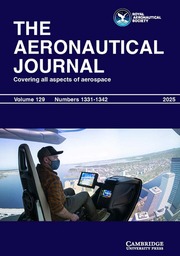Article contents
Sparse identification of parafoil dynamics model for path planning
Published online by Cambridge University Press: 13 October 2025
Abstract
In the field of parafoil airdrop path planning, the inherent complexity and time-sensitive nature of mission requirements necessitate rapid path generation through low-order mathematical models that approximate the system’s true dynamics. This study presents a novel sparse identification framework for constructing a parafoil path planning approximate model. Leveraging high-fidelity 9-degree-of-freedom (9 DOF) dynamic simulation data as training inputs, our method identifies simple nonlinear relationships between 3D positional coordinates (for spatial targeting) and yaw angle (for directional control), which are critical path planning parameters. Compared to conventional 4 DOF models, experimental validation using field airdrop data reveals that the proposed sparse model achieves enhanced predictive accuracy while maintaining computational efficiency. Quantitative analysis demonstrates reductions in root mean square error (RMSE) by approximately 12.96% (horizontal position), 54.44% (height) and 37.96% (yaw angle). The efficacy is further confirmed through successful fixed-point homing across diverse initial deployment scenarios, underscoring its potential for parafoil path planning.
Information
- Type
- Research Article
- Information
- Copyright
- © The Author(s), 2025. Published by Cambridge University Press on behalf of Royal Aeronautical Society
References
- 1
- Cited by


